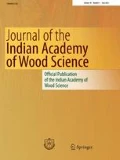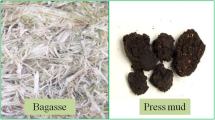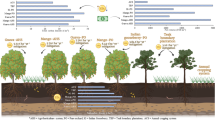Abstract
Little information exists on the properties of tropical tree species that are now being used in plantations in different tropical countries including Ghana. In this study, the variation in chemical composition and natural durability of both plantation grown and natural African Mahogany harvested in Ghana were evaluated using TAPPI standards, ASTM D 1758-06 (2008) and AWPA E-7-07 (2008). The total extraneous materials in plantation grown Africa Mahogany was relatively higher than the natural stands. Results showed that the alcohol extractives in plantation and natural samples were 2.7 and 1.8% respectively. However, the natural samples recorded higher cellulose, holocellulose and lignin contents of 39.2, 32.2%; 66.4, 61.4% and 17.3, 15.2%. After 26 weeks of assessment of the natural durability under the graveyard test, the bottom portions of both types of mahoganies were rated as moderately attacked, the middle portion rated as moderate to severe attack while the top portion rated as severely attacked. Moreover, both the plantation grown and naturally grown mahoganies were rated as moderately to severely attacked after 26 weeks exposure in the field. It is recommended that as plantation of indigenous species are encouraged, their properties should be evaluated to enhance their acceptance and utilization.



Similar content being viewed by others
References
Antwi-Boasiako C, Pitman AJ (2009) Influence of density on the durability of three Ghanaian timbers. J Sci Technol 29(2):34–45
Essien C (2012) Physical, anatomical and treatment characteristics of the wood of Cola gigantea and Ficus sur. Master of Philosophy Thesis, Faculty of Renewable Natural Resource—Kwame Nkrumah University of Science and Technology, Kumasi, Ghana, pp 196
Haygreen JG, Bowyer JL (1996) An introduction: forest products and wood science. 3rd edn. Iowa State University Press, Ames, Iowa
International Tropical Timber Organization (ITTO) (2004) The database of tropical industrial lesser-used wood species from tropical countries. Reference Guide to Tropical Timber species. Nagoya University Muscum, Nagoya, ITTO/PD 58/97
International Union for Conservation of Nature and Natural Resources (IUCN) (2004) Red list of threatened species. The world Conservation Press, Cambridge
Maiti R, Rodriguez HG, Kumari A (2016) Wood density of ten trees and shrubs and its possible relation with a few wood chemical compositions. Am J Plant Sci 7:1192–1197
Malik J, Santoso A, Mulyana Y, Ozarska B (2016) Characterization of Merbau extractives as a potential wood-impregnating material. BioResources 11(3):7737–7753
Opuni-Frimpong E (2008) Plant Resources of Tropical Africa 7(1) Timbers 1. PROTA Foundation, Wageningen, Netherlands/Backhuys Publishers, Leiden, Netherlands/CTA, Wageningen, Netherlands, pp 329–333
Oteng-Amoako AA (2006) 100 Tropical African timber trees from Ghana: tree description and wood identification with notes on distribution, ecology, silviculture, ethnobotany and wood uses. Graphic Packaging, Accra, Ghana, pp 168–173
Sablík P, Giagli K, Pařil P, Baar J, Rademacher P (2016) Impact of extractive chemical compounds from durable wood species on fungal decay after impregnation of nondurable wood species. Eur J Wood Prod 74:231
Suttie ED, Orsler RJ (1996) The influence of natural extractives of opepe (Nauclea diderrichii) and African padauk (Pterocarpus soyauxii) Timbers on their Durability. Section 3. Wood Protection Chemicals. IRG/WP 96-30098. Paper prepared for the 27th annual Mtg., Gosier Guadeloupe. 19–24 May, 1996. IRG Sec’t. Stockholm, Sweden, pp 1–15
Syafii W, Samejima M, Yoshimoto T (1987) The role of extractives in decay resistance of ulin wood (Eusideroxylon zwageri T. et B.). Bull Tokyo Univ For 77:1–8
Tekpetey SL, Riegel A, Dekomien K (2015) Investigating surface quality of African Mahogany (Khaya ivorensis) from Ghana using stylus and deflectometry techniques. Wood Fiber Sci 47(2):190–198
Yamamoto K, Hong LT (1994) A laboratory method for predicting the durability of tropical hardwoods. Japan International Research Centre for Agricultural Sciences. JARQ 28(4):268–275
Acknowledgements
The authors are grateful for the financial support of the International Tropical Timber Organization for the Mahogany project at Forestry Research Institute of Ghana. We are also thankful to the Management and staff of Log and Lumber Limited, Kumasi for the harvesting and processing of the Mahogany trees and samples.
Author information
Authors and Affiliations
Corresponding author
Rights and permissions
About this article
Cite this article
Tekpetey, S.L., Essien, C., Appiah-Kubi, E. et al. Evaluation of the chemical composition and natural durability of natural and plantation grown African Mahogany Khaya ivorensis A. Chev. in Ghana. J Indian Acad Wood Sci 13, 152–155 (2016). https://doi.org/10.1007/s13196-016-0179-1
Received:
Accepted:
Published:
Issue Date:
DOI: https://doi.org/10.1007/s13196-016-0179-1




